HISTORY
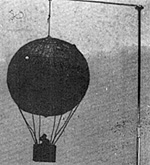 Man has, for centuries, dreamed about human flight. Men such as Icarus
of Greek legend, and Leonardo Da Vinci worked out schemes to achieve
flight. And it wasn't until men thought about lighter than air vehicles, for
which there is no counterpart in nature, that the hot air balloon concept
began its development.
Man has, for centuries, dreamed about human flight. Men such as Icarus
of Greek legend, and Leonardo Da Vinci worked out schemes to achieve
flight. And it wasn't until men thought about lighter than air vehicles, for
which there is no counterpart in nature, that the hot air balloon concept
began its development.
It was in the early 18th Century that Lourenco cle Gusmao developed his first small balloon. In 1783, the brothers Joseph Michel and Jacques Etienne Montgolfier designed and built larger and larger balloons (the Montgolfier). And on June 5,1783, they publicly launched their23,430cu. ft. balloon. By September of the same year the first passengers were carried intothe air; a sheep, a duck and a rooster. On November 21,1783, jean Francois Pilatier cle Rozier and Marquis Francois Laurent d'Arlanes became the first men to fly.
Fictional stories have had balloons carry passengers around the globe, as in "Around the World in 80 Days", or delivering passengers to the shore of some uncharted island as in "Mysterious island" by Jules Verne.
The balloon eventually found its way into military service.
MILITARY USES
The first military use of the hot air balloon came in 1793, when Jean Marie Contelle of the French Army made two four-hour observation ascents. Although no considerable intelligence was gained, the morale of the enemy troops was greatly affected.
In the American Civil War, at the Battle of Fair Oaks during the Peninsular Campaign, the Intrepid, T.S.C. Lowe's Federal observation balloon, was used to reconnoiter the battlefield.
Major General Fitz-John Porter, a Union commander at the Battle of Yorktown, used the balloon as a reconnaissance move.
Another military use of the balloon was propaganda distribution. Dropping thousands of propaganda pamphlets over populated enemy areas could help demoralize enemy troops and civilian sympathizers.
Other later uses of the balloon have been antiaircraft barrage balloons and high altitude relay stations. Aerial photography, exploration, and mail transportation have also been uses of the balloon.
Not all balloons were filled with hot air. Hydrogen gas was used early on and then helium was used. Probably the most famous hydrogen balloon was the Hindenberg, which exploded at its Lakehurst, N.J. landing site following a cross-Atlantic voyage.
The development and use of the balloon is as interesting as it is varied. As a miniature gamer I desired to include the balloon and some of its uses in my games to add some additional variety and fun!
CONSTRUCTION
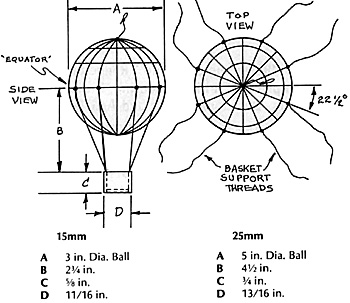 Balloon assembly is quick and easy. A styrofoam ball, thick brown thread,
white glue, some cardboard stock, and a little paint will be required. The
plans for building 25mm and 15mm balloons are given in the drawings
below.
Balloon assembly is quick and easy. A styrofoam ball, thick brown thread,
white glue, some cardboard stock, and a little paint will be required. The
plans for building 25mm and 15mm balloons are given in the drawings
below.
First, lightly spray paint the 'balloon' gray or tan with acrylic enamel. When dry, insert two straight pins in opposite postions on the ball. Tie one end of the brown thread to the top pin. Wrap the'thread around the ball to the pin on the bottom. Wrap the thread around it once and then continue around the other side of the ball. Repeat the wrapping procedure every 221/2 degrees, rotating the ball for each trip around the ball. Finally, tie the end to the top pin and press both pins into the ball. Be sure to leave about 3 inches of thread loose here to be aboe to hang the balloon. Dab a little white glue over the pins to firmly hold in place. When done there will be 16 threads going top to bottom around the ball.
Next add three more threads horizontally around the ball. Tie one end to one of the vertical threads and wrap it around the ball, but at each crossing of a vertical thread, loop the horizontal thread around it before continuing on. The lowest of the three threads should be positioned at the 'equator' of the ball. Each of the next two horizontal threads should be 1/3 and 2/3 the distance to the pin at the top of the ball.
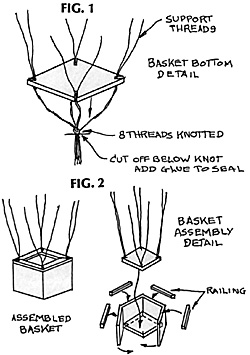 Now the basket support threads can be tied to the crossings of the
equatorial and vertical threads. These will be cut to the same length and
tied carefully together to provide support for the bottom of the basket. 8
threads will be tied in this manner, from every other thread crossing. See
the drawings for dimensions of the final assembly.
Now the basket support threads can be tied to the crossings of the
equatorial and vertical threads. These will be cut to the same length and
tied carefully together to provide support for the bottom of the basket. 8
threads will be tied in this manner, from every other thread crossing. See
the drawings for dimensions of the final assembly.
The basket bottom is cut square and slotted at each corner. Insert the piece (see fig 1) over the knot and arrange the support threads in pairs in each corner slot. Cut and assemble the basket sides and railings as shown
Detail can be added, such as a figure with binoculars and sand bag weights, as desired. The basket should be painted brown.
The balloon will need to be supported in some manner during a game session. A retractable hanging stand made from a telescoping antenna would be ideal, and give the ability to raise and lower the balloon as it changes elevation. With a moveable stand, movementof the balloon due to wind can also be achieved. HAPPY BALLOONING!
BALLOON RULES
The following rules are designed to allow use of the model observation balloon with almost any set of miniature rules. They will simulate Ascent, Descent, Free Movement, Visibility, Damage from Fire, and even Bomb Dropping. Changes in wind strength and direction will be randomized as will Bomb accuracy. Visibility restrictions are determined via formula, taking into account hill height and distancefrom the observation balloon. Some game specific suggestions for TSATF and ON TO RICHMOND will be included.
A few additional items will have to be fabricated, in addition to the balloon, to use these rules and these will be shown in the diagrams included.
The following balloon rules are very basic and are subject to modification at the reader's discretion.
In miniature games where a roster system is used, the casualties indicated in the tables can be converted to an appropriate CV value.
WIND
First determine the wind direction and velocity. Place the Compass Chart (Fig.3) so that the 'N' faces north on the table top. Roll a 20 sided die and rotate the pointer to the number rolled. This is the direction of the wind. The balloon will always move, when loose, in this direction. Next the wind velocity is determined by rolling a 10 sided die. The number rolled is both the velocity and the number of inches the balloon will move per turn.
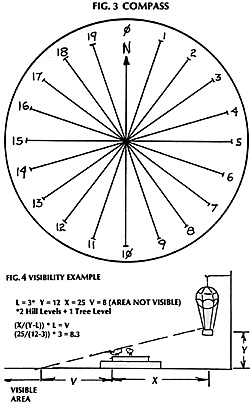 At the beginning of each turn changes of direction and velocity are diced
for. For direction roll two D10, using one as the Clockwise/Counter-
clockwise (CW/CCW) Rotation die, and the other as the number of
Compass Points. A roll of 0-2 = CW, 3-6 = No Change, and 7-9 = CCW
direction on the Rotation die. The second die indicates the number of
Compass Points to rotate. The new direction indicated is the new flight
path of the balloon.
At the beginning of each turn changes of direction and velocity are diced
for. For direction roll two D10, using one as the Clockwise/Counter-
clockwise (CW/CCW) Rotation die, and the other as the number of
Compass Points. A roll of 0-2 = CW, 3-6 = No Change, and 7-9 = CCW
direction on the Rotation die. The second die indicates the number of
Compass Points to rotate. The new direction indicated is the new flight
path of the balloon.
A third 10 sided die is rolled and the resulting number is the wind and balloon velocity.
DEPLOYMENT
The balloon takes 3 turns to deploy (inflated) from wagons. To deflate and pack up a balloon also takes 3 turns.
ASCENT AND DESCENT
The balloon may ascend and descend at 6 in. (150mm) per turn. It takes 1 turn to stop an ascent and 2 turns to stop a descent, unless landing. The balloon player must announce his actions at the beginning of his movement phase in regards to stopping ascent or descent.
A balloon that is anchored must ascend at the normal rate; however the descent rate can be doubled if a figure or stand is assigned to 'Wench Down' the balloon with the anchor rope. The balloon may descend, in this case, at 12 inches/turn.
MOVEMENT
The balloon will move, unless anchored, at the current wind velocity and in the direction of the wind. For TSATF the balloon will move on a red card. For OTR add a 'BALLOON' card to the movement deck.
VISIBILITY
Since the ground vs. figure scale of most miniature games is not 1/1, a 'Line of Sight' method of visibility will not work. In ON TO RICHMOND (OTR), for example, a 1 inch/50 yard ground scale is used. And in 15mm that would make each man 35 yards tall. As a result of this discrepancy, the following visibility rule was designed. Note: if any part of a stand is in the visible area, it can be seen.
The visibility limitations are determined by the following formula (see Fig. 4 for example):
- (X/(Y-L)) - L = V
where X = the distance of the far edge of the terrain from the balloon stand, measured to the whole inch (round down); Y = the altitude of the balloon, measured to the whole inch (round down); L = the number of terrain levels, counting trees as 1 level, seeing into woods as per local rules; V = the distance away from the terrain edge not visible (round down). Anything beyond, in clear sight, is visible to the observer.
The Hill Level vs. Visiblity Chart is provided so thatthe visibility calculation need not be made. There are 5 tables, each giving the visible areas based on the number of terrain levels the observer is looking over. Balloon altitudes are across the top of the table in increments of 6 inches. The distance of the balloon stand to the opposite edge of the terrain is given in the leftmost column. To use the tables simply find the table for the number of terrain levels and cross reference the balloon's altitude and the distance to the terrain piece. The number found where the column and row cross is the area beyond which things are visible in inches. The number is preceded by a greater-than symbol). In the example given Table 3A is used.
ARTILLERY AND MUSKETRY DAMAGE
When fired upon by artillery or musketry a balloon will take damage according to the following rule. One (1) hit by artillery will bring a balloon down at the normal descent rate. There is a 2 turn repair. Two (2) or more hitswill make the balloon descend at double rate, and will be unrepairable in the field. Musketry takes 3 hits to bring a balloon down. There is also a 2 turn repair for musketry.
For TSATF when determining a hit, roll a 1D6 and consult the table for the number of cards to turn; only the last card has any meaning. A heart face card or ace will be a hit on the balloon, while a spade face card hits a balloonist.
In OTR, the die roll is modified by+1. Roll for balloonist casualty the same way as for loss of commander. This will supersede a hit on the balloon.
In either game 10 inches is added to the measured range, only if the balloon is aloft, to determine actual range.
LANDING IN TREES
For all intents and purposes this is a no-no. An attempt to land in woods will be fatal to the balloon.
ANCHORAGE ANGLE
When a balloon that is anchored is aloft, the wind will blow the balloon in the direction of its normal movement so asto cause the anchor rope to be at some angle to the ground. This would cause the balloon to deviate from its anchor point according to its height and the wind strength. The Ground Scale distance from directly under the balloon and the anchor point is 1/10 the altitude of the balloon times the current wind strength. As an example, if the altitude of the balloon is 20 inches and the wind strength is 5, then the distance from directly under the balloon to the balloon's anchor point is 20 * 5 = 100/10 =10 inches. To demonstrate the rope,astringcan betiedtothe balloon basketand then terminated with a weight placed on the table top.
The Anchorage Angle Distance Chart is provided to determine the distance from theanchor pointto the balloon stand. The balloon altitude is given across the top while the wind strength is the leftmost column. Simply cross reference these two values to find the proper distance between the balloon stand and the anchor point.
The Anchorage Angle rule will allow bombsto be dropped on an enemy that is in close range of the balloon anchor point, without hitting friendly troops defending the area just around the anchor.
ANCHOR BREAKAGE
If the balloon is anchored to the ground while aloft, there is a possibility thattheanchor ropecan be broken if thewind velocity increases. This will simulate wind gusts. If the wind increases by more than 5 in./turn during any turn, a D10 is rolled. A zero (0) results in the anchor rope breaking and this allows the balloon to fly free.
It is allowed that either a balloonist or a figure or stand on the ground can cut the anchor rope.Thisaction must be declared and occursatthe end of the game turn. if the figure or stand attempting to cut the rope is fired at or meleed or otherwise attacked, the attempt fails. The attempt will succeed if 1 full turn is spent unimpeded.
BOMB DROPPING
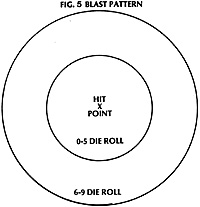 While a balloon is aloft, bombs can be dropped onto targets below. Only
one bomb can be dropped per turn. During any part of the balloon's turn
a bomb may be dropped.
While a balloon is aloft, bombs can be dropped onto targets below. Only
one bomb can be dropped per turn. During any part of the balloon's turn
a bomb may be dropped.
The Drop Point is marked and the Bomb Hit Grid is centered on that point. Two 10-sided dice are rolled and theactual hit location is determined. The X (red) and Y (black) scales of the Bomb Hit Grid (Fig. 4) are matched to the numbers rolled.
Then the Blast Pattern (Fig.3) is centered over the hit location. A third 10-sided die is rolled. If 0-5 is rolled the smaller diameter pattern is used, and if a 6-9 is rolled the larger diameter pattern is used. All figures or stands within the pattern are possible casualties.
For TSATF when determining a hit, roll a 1D6 and consult the table for the number of cards to turn; only the last card has any meaning. A heart face card or ace will be a hit on the balloon, while a spade face card hits a balloonist.
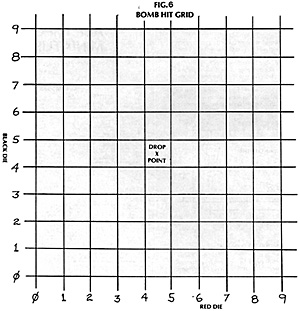 If, by chance, the anchor rope is within the bomb's Blast Pattern, then a
D10 is rolled. A 0 or 1 breaks the rope, allowing the balloon to fly free.
If, by chance, the anchor rope is within the bomb's Blast Pattern, then a
D10 is rolled. A 0 or 1 breaks the rope, allowing the balloon to fly free.
Bomb Casualty Chart
DIE ROLL : STANDS REMOVED
- 0-2 : 2
3-7 : 1
8-9 : 0
Only the stands that have any portion inside the pattern are candidates for extinction (see Figs. 5 and 6 for patterns).
BALLOON CAPACITY
A balloon can carry up to one balloonist and six bombs or two balloonists and 3 bombs.
Various Hill Level vs. Visability Charts (Extremely slow: 837K!)
Back to Table of Contents -- Courier Vol. VII #4
To Courier List of Issues
To MagWeb Master Magazine List
© Copyright 1987 by The Courier Publishing Company.
This article appears in MagWeb (Magazine Web) on the Internet World Wide Web.
Other military history articles and gaming articles are available at http://www.magweb.com